Railroad Models / Eisenbahn-Modelle
Haslingen Steel Mill
- Details
- Kategorie: americaN
FREMO module in N scale
Haslingen Steel Mill
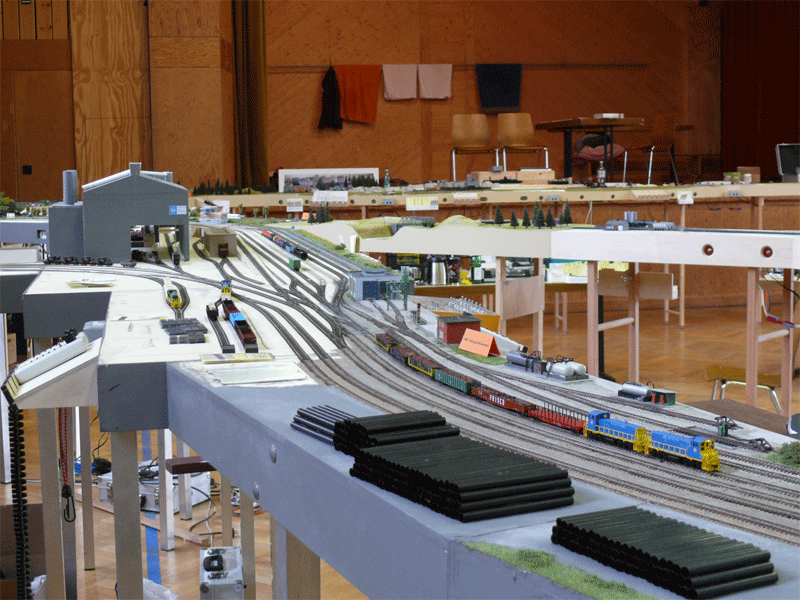
Haslingen Steel at the americaN meeting in Lauffen, Germany, 2011.
Schematic track plan of Haslingen Steel.
Haslingen Steel can be operated as the European version “Stahlwerk Haslingen”, too.
At the FREMO meeting 2008 in Naumburg (Kassel, Germany), Stahlwerk Haslingen was integrated in the European part of the huge N scale layout.
Jan Schirling has planned and built this module for “N Europe”. I asked him if he was interested to operate it as an American steel mill, too. He liked this idea. As the status of building was in an early stage, it was not too late to add the planning and fine tuning for the setup of both versions, the German and the American. Elements that would be changeable would be labeling and signals. The standards at the ends of the modules, or the DCC system, are the same on American and European N FREMO.
Jan succeeded to add the variability, and in July 2011, Haslingen Steel was at an americaN meeting for the first time.
At the FREMO meeting in Naumburg, 2008, Stahlwerk Haslingen was integrated in the German branch of the huge layout:
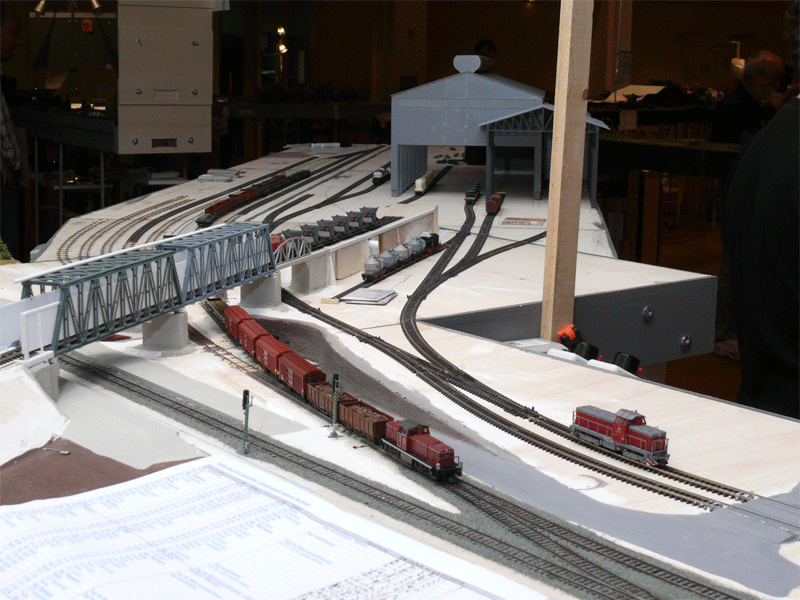
East side of Haslingen Steel. The main track of the class 1 railroad "Deutsche Bahn" is in the foreground, the train is passing from steel mill track to Deutsche Bahn. (Status of 2008)
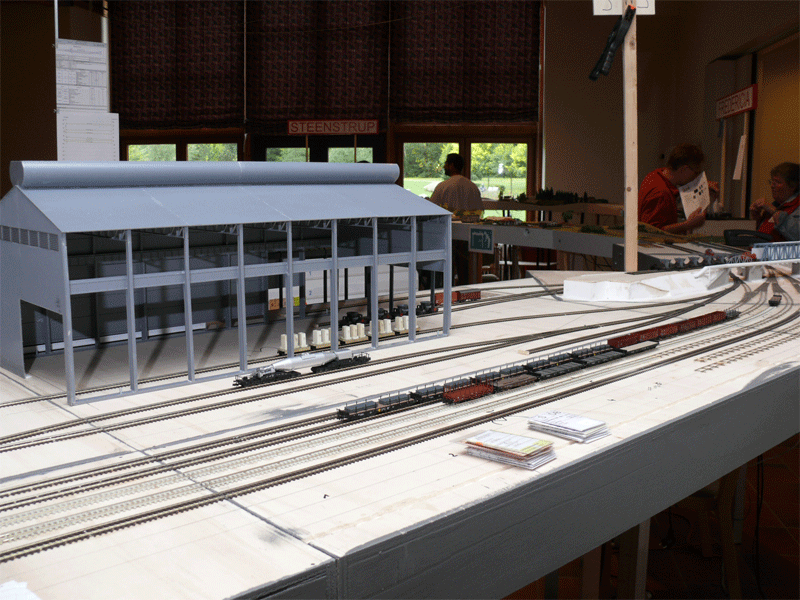
middle part
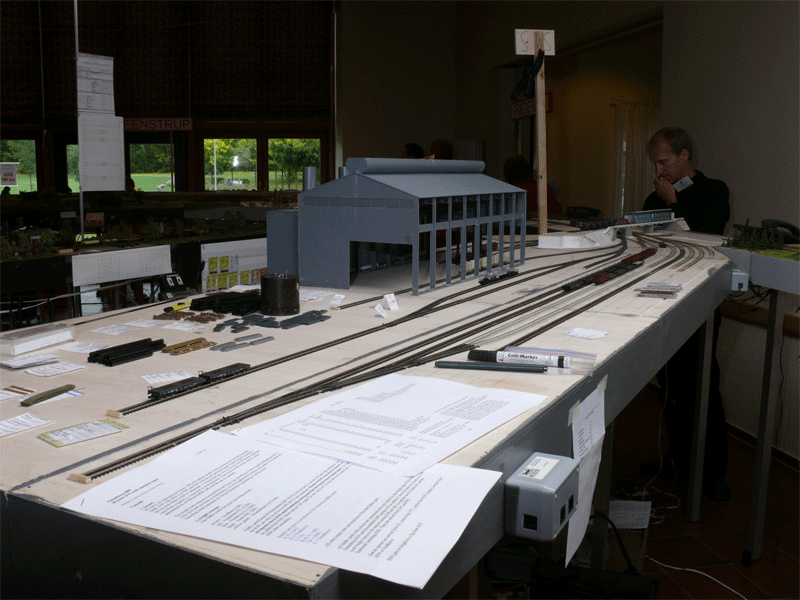
looking from west
Between 2008 and 2011, Jan made good progress. At the Lauffen meeting in July, 2011, Haslingen Steel was first time operated the americaN way.
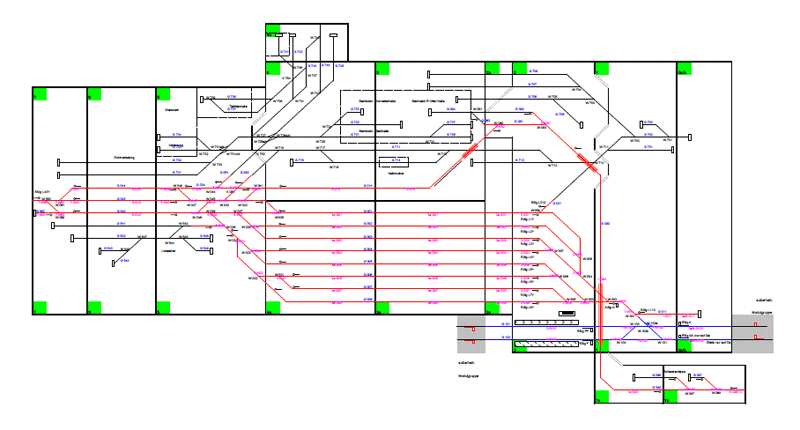
Track plan of Haslingen Steel status June, 2011

Haslingen Steel was set up at the americaN layout for the first time. It has been built to fit at European and US N scale module layouts with FREMO standards. View from west.
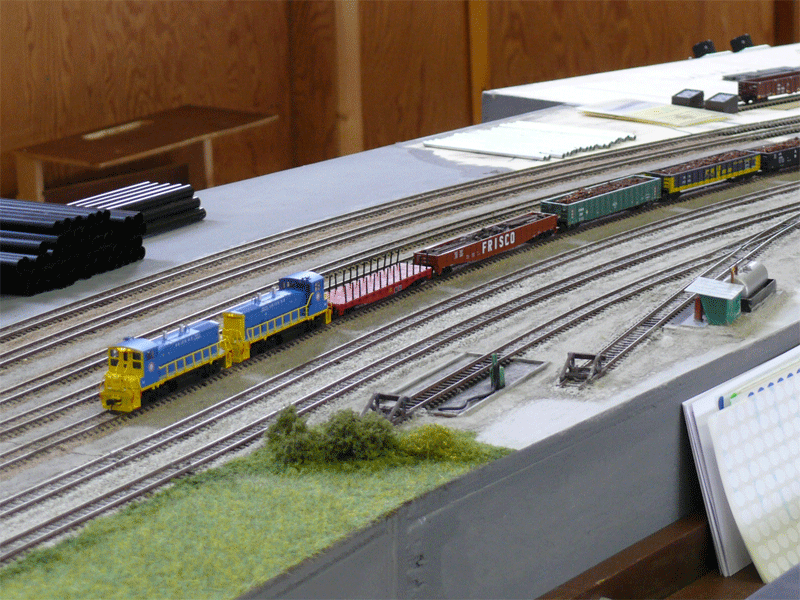
Tank spot for steel mill engines
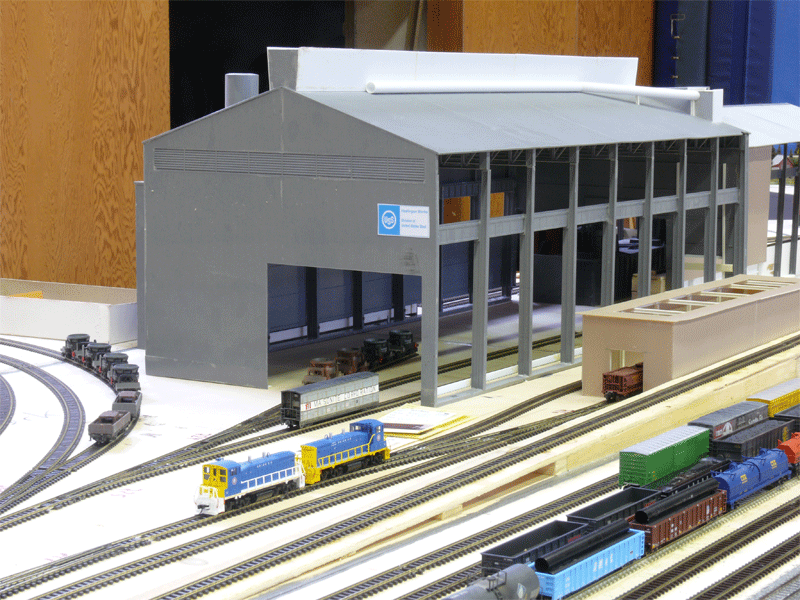
Haslingen Steel is an electric arc furnace. The biggest amounts of products coming in by rail are scrap and burnt lime. Outgoing products are steel as coils, sheets and tubes, and hot slag. On this plant, metal products of other companies are continued to process, too. Therefore, there is a lot of rail traffic inside this plant.
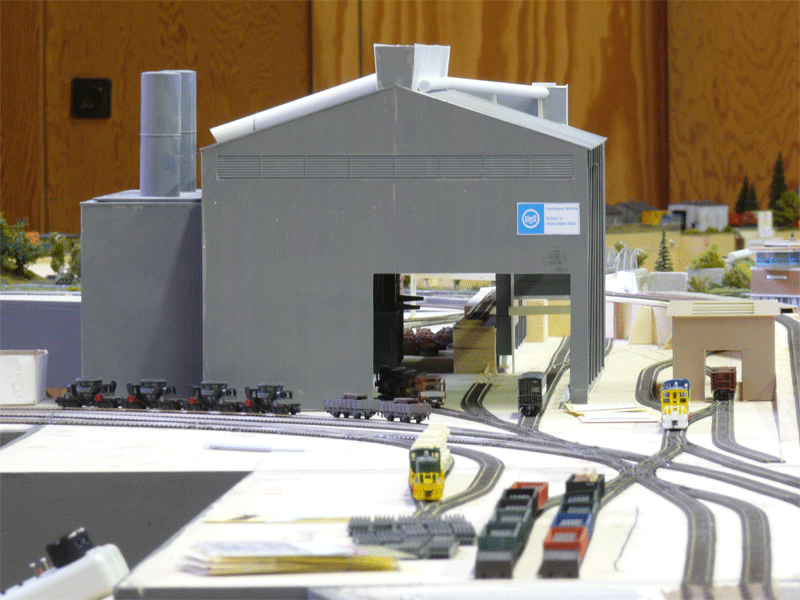
At this side of the shop, the hot slag cars are pulled out.
Scrap is transported into the shop from the other side.
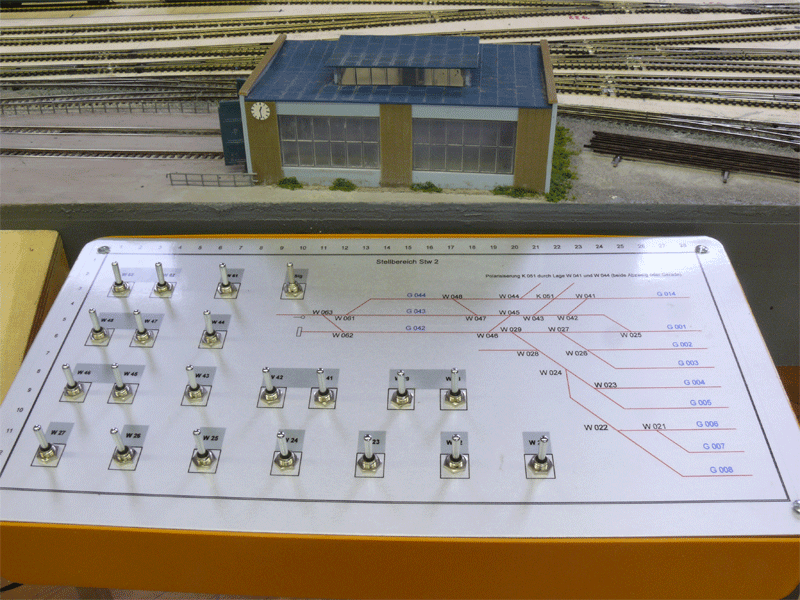
On the west side of Haslingen, this control panel is used.
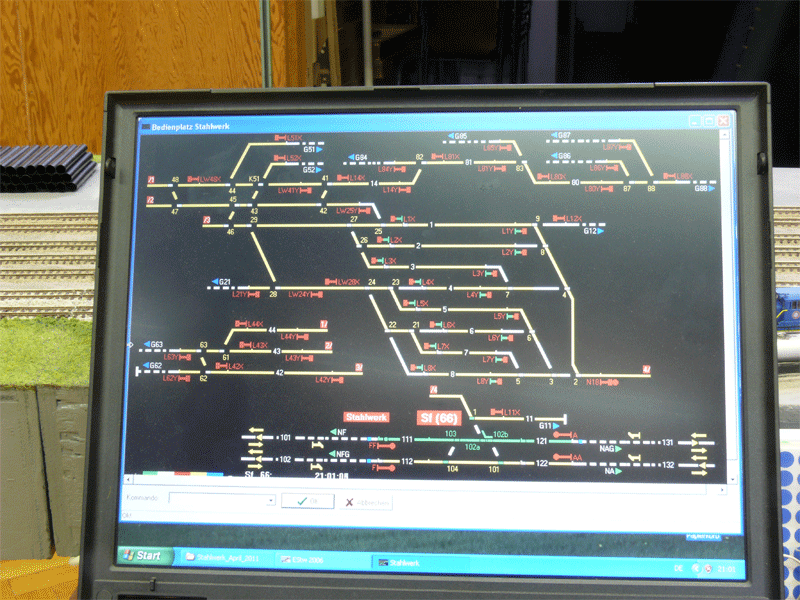
At the east side, this new computer system is in test, and maybe will replace the old panel on the west side.
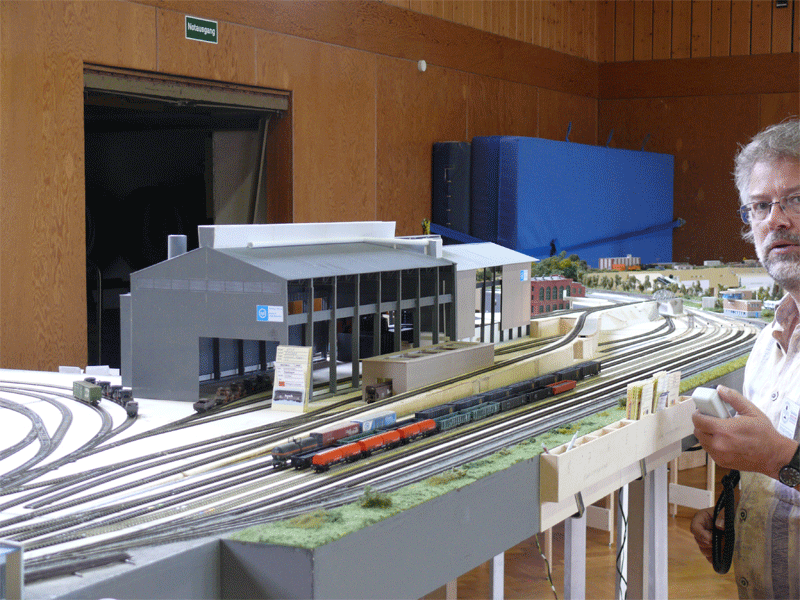
Enjoying the job as Haslingen Steel yardmaster
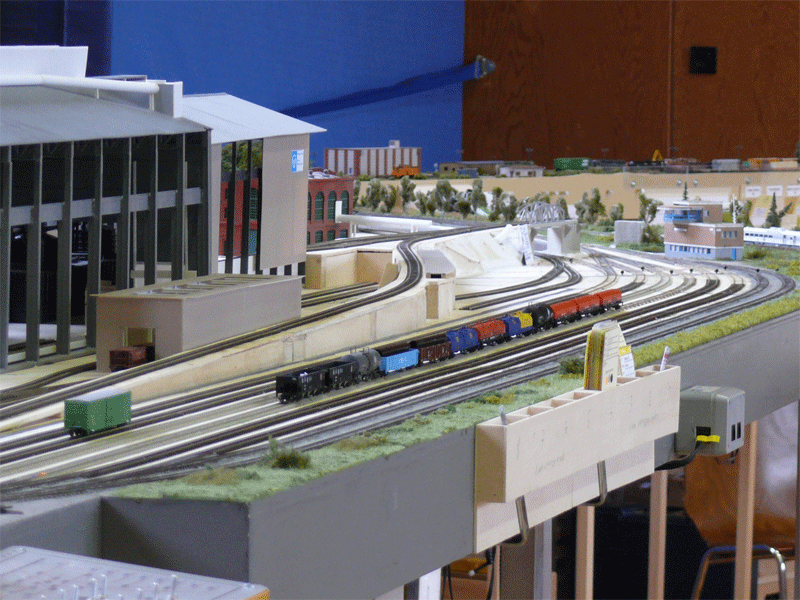
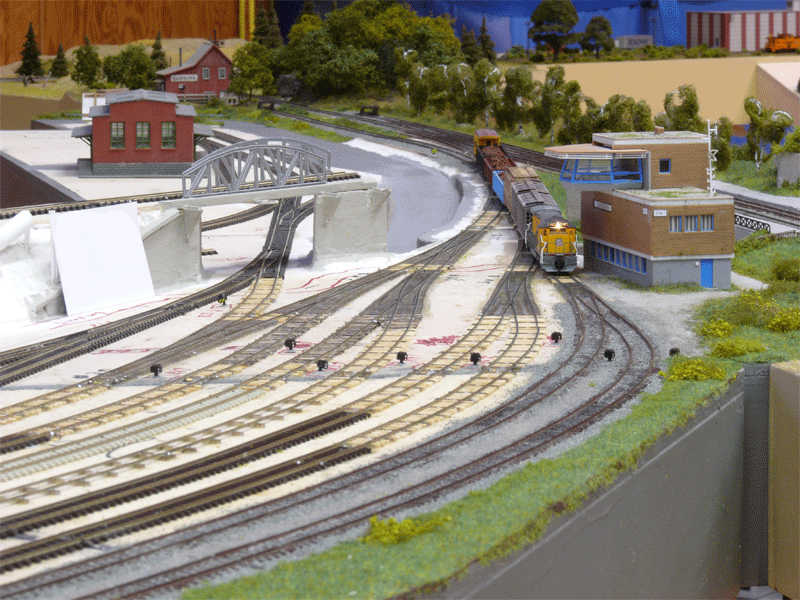
A train with scrap is arriving.
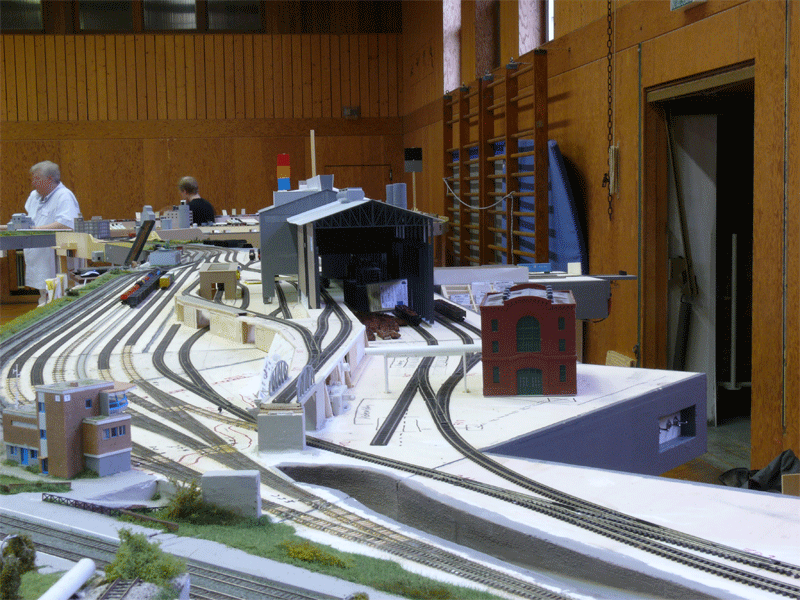
View from east. On the right, scrap is transported into the shop.
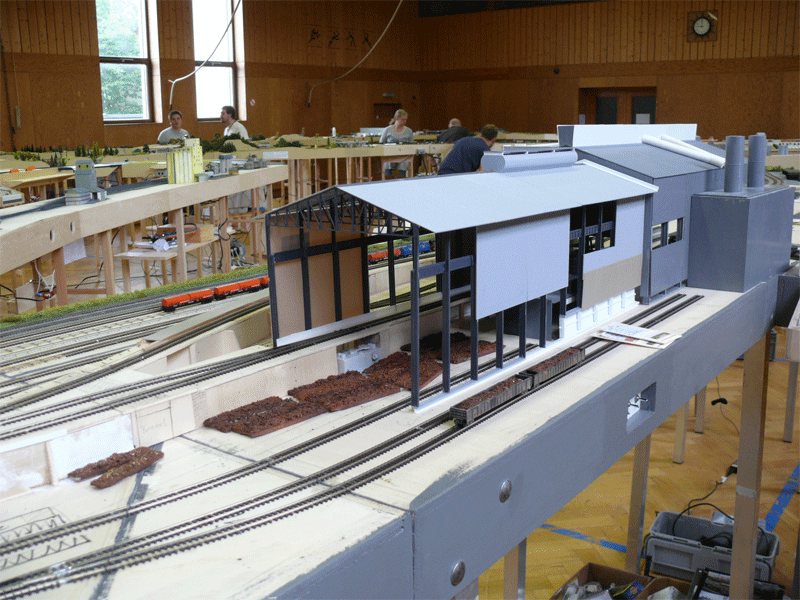
Detail of the scrap processing. Haslingen Steel is operated from both sides. To use all possibilities of internal and external traffic, three operators are needed.
Jan Schirling, planner and builder of this module, explains:
I had the idea to build a steel mill a long time ago when I was planning a home layout.
Then, I got positive experienced with FREMO in H0 scale. Therefore, I dismissed the fixed home layout in favor of a modular setup.
As such a company is generating a massive amount of freight, large track arrangements are needed. Therefore, an internal interchange had to allow a good traffic flow, with effective track length of 8.5 ft. (2.5m) which is the suggested length in FREMO N standard for main line traffic. This was the first requirement.
The second was space in my car. As the larger buildings are stored off the modules, the segments can be transported by pairs. Therefore, it was possible to plan a group of modules 23 ft. (7 m) in length.
As a connection to the main railroad only on one offered a reduction in space, I was looking for an adequate prototype. The connection of the steel mill in Duisburg-Ruhrort (Germany) could not been replicated because of size, but some aspects were used, for example the undergrade crossing of the street.
From other prototype steel mills design elements were adopted, too. One is the supply of liquid iron on a high line, as done in some steel mills. After choosing this design, it offered the chance to cross the main railroad with a bridge, and to add a connection for modules and a hot slag dump area on the other side of this ramp.
The track system has following elements:
-
two track main line of the connecting railroad, with crossing, passenger station (please remember: the German railroad system has a lot of passenger service), and junction to the steel mill railroad interchange yard
-
interchange yard with 8 tracks, six of them with effective length of 2.6 m (8.6 ft.)
-
three tracks inside the steel mill for internal car classification, and as switching point before transporting cars to the product processing areas
-
the high line: one track starting at this internal classification yard which runs parallel to the interchange yard. It rises from this yard until it crosses the main railroad line with a bridge. Near the bridge, it has a passenger station, where the passengers can interchange to the passenger service of the main railroad using a pedestrian overpass. Then, this track slopes down until it reaches the level of module standard.
-
switching tracks connecting the product processing areas
-
engine service area for steel mill engines
The main railroad tracks can be connected to one or double track modules on both sides. (on the graphic: east side of the plant, connection north – south).
Other connection points to one track modules are
-
at the end of the track with crosses the main railroad with the bridge (east)
-
at the end of the interchange yard (west)
-
at the north side of the steel mill plant is the rolling mill. At this point, modules can be added, too
The interchange to the main railroad, and the switches at the east side of the interchange yard, are controlled by an electronic interlocking plant (= laptop).
On the west side, there is a control panel with pushbuttons. It is planned to replace it by an electronic interlocking plant.
All other switches are thrown by pushbuttons, which are placed close to the switches at the south and the north sides of the module.
Elements of Haslingen Steel Mill:
-
Steel Mill with electric arc furnaces and converters and rolling mills. The Steel Mill is receiving scrap which is shipped in open gondolas. This scrap is melted down in the two electric arc furnaces. If there is a blast furnace somewhere in the layout, or this can be simulated by a staging yard, hot metal can be delivered by hot metal cars. If these cars are arriving by the main railroad, they have to be approved by these railroads. If these cars are run inside the steel mill area, hot metal “torpedo” cars or ladle cars can be used. In the converters hot iron and /or the scrap are processed to steel.
-
Next to the electric arc furnaces and converters is the underground bunker for burnt limestone. Burnt limestone, which is needed in the melting process, is arriving in covered hoppers.
-
On two tracks inside the building liquid steel is filled into ingot molds which are transported on special flat cars.
-
Hot slag is transported in slag cars to the slag dumping area by rail.
-
All these elements are realized on this steel mill module, or will be added. The interior of the building will be recreated partially.
Along the blooming mill are the soaking pits. Here, the ingots are stripped from the molds and placed in the soaking pits to equalize the temperature. This processing area is modeled, too.
The blooming mill can be modeled only partially. Maybe there will be one or two roll stands. In the blooming mill the glowing steel slabs are rolled to half-finished products like slabs and billets. Modeled are two tracks in the storing and loading area for slabs and billets. These are shipped by flat cars or gondolas.
Only virtually are the processing plants for sheet metal and large pipes. The open air storing and loading area for these pipes is modeled, too.
Beyond the described production chain, on the company areal there is a zinc coating shop. It receives coils in open or covered cars, and ships galvanized coils and galvanized thin sheets in covered cars.
Adjacent to the zinc coating shop is a weather protected unloading facility. Inside, tank cars deliver acid.
To treat the process gases of the steel mill, a power plant is on the north side of the module. If there are blast furnaces somewhere on the layout, those gases are used in the power plant, too: there is a gas pipeline parallel to the single track.
Ashes from this power plant are removed by rail with open hoppers.
Slag of the steel mill is transported to a slag dump, which is also modeled, by slag cars. When the hot slag got cold, it will be processed to construction materials used in road building or otherwise. The processed slag is transported by rail or truck. There is a magazine at the lag processing plant, which is receiving goods by rail.
This slag dump and slag processing plant is on the most “eastern” part of Haslingen Steel schematic plan (see above), and this module can be placed separately, at any part of the layout, as done in Lauffen 2011.
Every spot where freight is taken out of open cars (scrap, coils, slag) or is loaded into (slabs, billets, iron sheets, pipes, and slag) can be reached by hand. Therefore, the movement of freight is simulated, too.
Text: Jan Schirling, translation: mh
Builder of Haslingen Steel: Jan Schirling
Status: 09.08.2011
Additions since June 2011:
-
Additions Haslingen Steel Mill, at N Scale Convention Prague 2011, September 2011
-
Progress Haslingen Steel Mill, at americaN Meeting in Lauffen, May 2013
- Haslingen Steel Mill - Update Lauffen 2015
Video:
In this video you will see scrap car switching inside Haslingen Steel mill.
Video:
Train with Hot Slag Cars from Haslingen Steel to Slag Prep Plant via Colorado Cement and 2nd Street. FREMO americaN Meeting in Lauffen, 2011.
Switching inside Haslingen Steel Mill: scrap turn. Nied, March 2012
Haslingen Steel Mill: hot slag turn. Nied, March 2012

